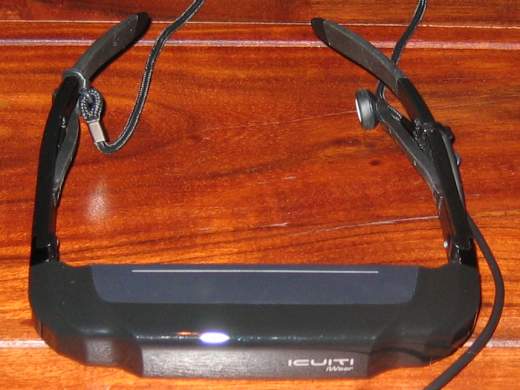I recently received my VR920 3D stereo glasses from USA. A detailed review of the device can be found here : Introducing the Vuzix iWear VR920. A photo of the VR920 can be seen below:
The device of course works flawlessly using Windows. The situation under Linux is a bit different, due to missing driver support from the manufacturer, as usual.
Stereo vision works at least with nvidia quadro boards, probably also with others. I.e. Ati FireGL should work, but I never tried this. Setting this up was easy. I only had to start a second XServer and add the line
Option “Stereo” “1″
into the screen section of its xorg.conf. With this setting you get a different image for both eyes and thus real stereo vision if your application supports quad-bufferred stereo. It is important that the screen resolution is between 640×480 and 1024×768 and the refresh rate is 60 Hz. The xorg.conf you are using for this must not use the composite extension. For disabling the Composite extension append the following to the xorg.conf:
Section “Extensions”
Option “Composite” “Disable”
EndSection
Sadly this also prevents the use of compiz, hopefully Nvidia fixes the incompatibility between stereo and the composite extension some day.
For starting the xserver i use the following little script, which opens 2 xterms and starts the program (given as parameter with arguments) in one of them.
#!/bin/bash
/usr/X11R6/bin/X :1 -dpi 96 -xf86config ./xorg.conf.3d -auth /var/gdm/:1.Xauth vt8 &
DISPLAY=:1.0
export DISPLAY
sleep 5
icewm&
hotkeys&
xterm -fn 9×15&
xterm -fn 9×15 -e $@&
The headphone gets detected as alsa device:
usb 2-2: new full speed USB device using uhci_hcd and address 8
usb 2-2: configuration #1 chosen from 1 choice
generic-usb 0003:1BAE:0002.0002: hiddev0,hidraw1: USB HID v1.00 Device [Icuiti Corp. VR920 Video Eyewear] on usb-0000:00:1d.1-2/input3
usb 2-2: New USB device found, idVendor=1bae, idProduct=0002
usb 2-2: New USB device strings: Mfr=1, Product=2, SerialNumber=0
usb 2-2: Product: VR920 Video Eyewear
usb 2-2: Manufacturer: Icuiti Corp.
usbcore: registered new interface driver snd-usb-audio
cat /proc/asound/cards:
1 [ Eyewear ]: USB-Audio – VR920 Video Eyewear
Icuiti Corp. VR920 Video Eyewear at usb-0000:00:1d.1-2, full speed
I was able to get mplayer to play on the device by setting the output device to hw=1,0 .
Sadly the mixer does not seem to work. At least the mixer levels are not controllable. Perhaps any alsa developer has an idea for this? It is even more important since the mixer control wheel at the device freezes after three steps when using linux.
More important than having controllable sound is to get the integrated headtracking to work. There is a non-working driver at vuzix forums. At least it can read the sensor data from the device but does not seem to handle the data correctly. I will look into this soon.
Update: My VR920 headtracking driver is now available here: VR920 headtracking driver for Linux
Playing with the device I had to find out that there is no jps stereoimage viewer for linux. The only programm I found, which is able to read jps-images, is gqview (GQView3D). Sadly gqview is not able to display theese images using active quad-buffered stereo. Thus I decided to write my own jps viewer. It will be based upon OpenSceneGraph (OpenSceneGraph) since I have some experience in OpenSceneGraph development. Perhaps I can integrate headtracking into it. Would be really cool to view a sea panorama image in 3D by turning the head 
Stay tuned for updates.
Jürgen

Loading...
Posted in 3d, hardware, linux | 22 Comments »
 MyGNU.de
MyGNU.de






![Validate my RSS feed [Valid RSS]](https://validator.w3.org/feed/images/valid-rss.png)

